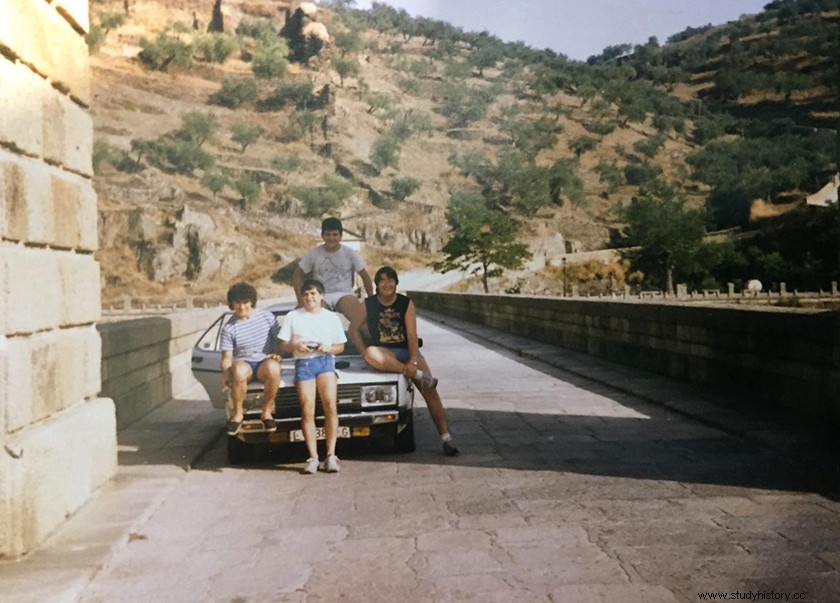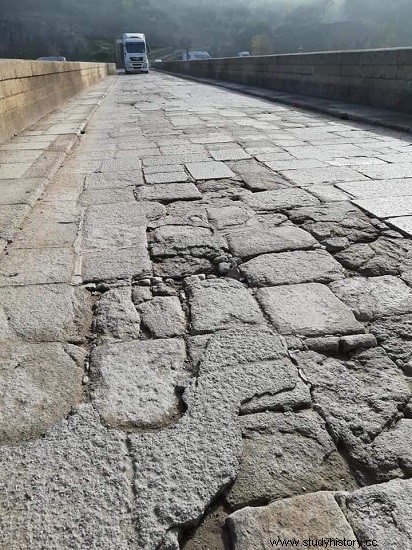
I have always heard of the Alcántara Bridge, my parents Eusebio and Candela were born in that famous town in 1926. They, along with their countrymen, used to talk to me about it. Post-war children and adolescents who in many cases did not have the fortune to have access to education, spoke of it with pride. “Yes, our town has the oldest and best preserved bridge in all of Spain”, was the phrase that came out of them at those family gatherings, or also; "Well, we haven't gone down times, along that little path that goes from the convent of the nuns to the bridge." Without a doubt, despite not knowing the real importance of such an impressive construction, his phrases and conversations denoted a special affection for that bridge.

Alcantara Bridge
It is not necessary to remember that, in the 80s, without television channels, without google, without youtube, the only images of the Alcántara Bridge that I had, came from the photographs , which adorned the walls of Extremaduran cultural centers in Catalonia. Well, there I was in that torrid summer of 1987 (I assure you that it is not a complete strawberry), to find the Alcántara Bridge for the first time, by the way, for the curious, in the image the first on the right. It is necessary to point out that the reason that brought me to my parents' town when I was 18, was not the parties next to Bar Lisboa, where the children of immigrants from different parts of Spain used to get together, or yes, well let's leave this matter for another occasion.
At that time in my life, I was an unmotivated student in the second cycle of Vocational Training, specializing in Electronics. So after stepping on the bridge I became aware of something that was constantly on my mind. Questions began to appear in my mind; How has it stood for 2,000 years? the Romans were its builders, but when? What happened during the other historical periods? In short, it was the verification of my mistake when choosing studies after the EGB. Fortunately, over time I have decided to correct my mistake.
I now know that the bridge was built in the early 2nd century AD. C., specifically between the years 103-106, during the mandate of the greatest emperor that Rome had. A certain Trajan, who to make matters worse was born about 300 km south of the majestic Roman bridge of Alcántara. Now I can also relate that his work was financed by a series of towns, which from Augusta Emerita traded with the current region of the Portuguese Beira, and that he saw carts loaded with minerals and agricultural products pass by. What, although it was not considered one of the busiest roads in Roman Hispania, its engineer Cayo Julio Lacer was completely right with its construction system. Its six arches rest on five pillars, the central one always covered with water and the two successive ones for much of the time. Therefore, its foundation, precisely lowering the natural rock of the area, was the key for the waters of the Tagus River to respect them for thousands of years.
But above all we know that if it is standing today, it is because of the efforts of the people from Alcantara and many other people throughout history. With great probability until 1213 the bridge remained intact, as the famous Muslim geographer Al-Idrisi said; in the twelfth century it was one of the wonders of the world. But at that time the fights between the Almohads and the king of León, Alfonso IX, led him to lose the first arch on the right bank. It must have been repaired after a few years, to live one of the anecdotes that will surely make us reflect at the end of this article. The same occurred at the end of the fifteenth century in the midst of the war between the Portuguese and Castilians; at one point the Duke of Villahermosa, brother of Fernando de Aragón, threatens to pull the bridge down. The King of Portugal's response was forceful; “don't throw the bridge, to conquer Castile I will surround it by another place so as not to wear it out, what's more, I don't want the kingdom without said bridge ”.

Engraving of the bridge from the 19th century, before its last reconstruction.
Later great kings such as Emperor Carlos V, or Carlos III in the 18th century left their mark on the monument after two repairs. In 1858, when Elizabeth II was reigning, thanks to the efforts of the Academy of History, the central triumphal arch was repaired to acquire its current appearance. Of course, in all of them the original layout was respected, which our ancestors built in the 2nd century.
Suddenly we arrive at the 21st century, where anyone can check the deterioration that the Alcántara Bridge has suffered in recent years, and what do we find? Well, some authorities that turn their backs on the problem, it is honestly difficult to understand that a construction like this has not been classified as a World Heritage Site, instead, it has to continue to support the passage of trucks over it. Mr. Felipe VI, possibly I'll go where they don't call me, but maybe it would be great if our descendants would find a plaque on the Puente de Alcántara with his name, although honestly I have little hope.

Image of the bridge today, published by the friends of the Dia de la Romanidad.
I have no choice, in memory of that summer of '87, but to appeal to my friends who promote Romanity Day. Federico Romero, Pedro Villanueva and León Arsenal, what a fantastic idea you had promoting that festivity, and again denouncing in recent days the deterioration of the Alcántara Bridge. Thank you for your effort, and of course, from Walking through History, we join in any action that is promoted from your association. To the readers, I invite you to read this article to learn first-hand about its current status:diadelaromanidad.
More info:
Popular Notebooks, Juan J. Villarroel Escalante, Ed. Regional de Extremadura, 1991.
